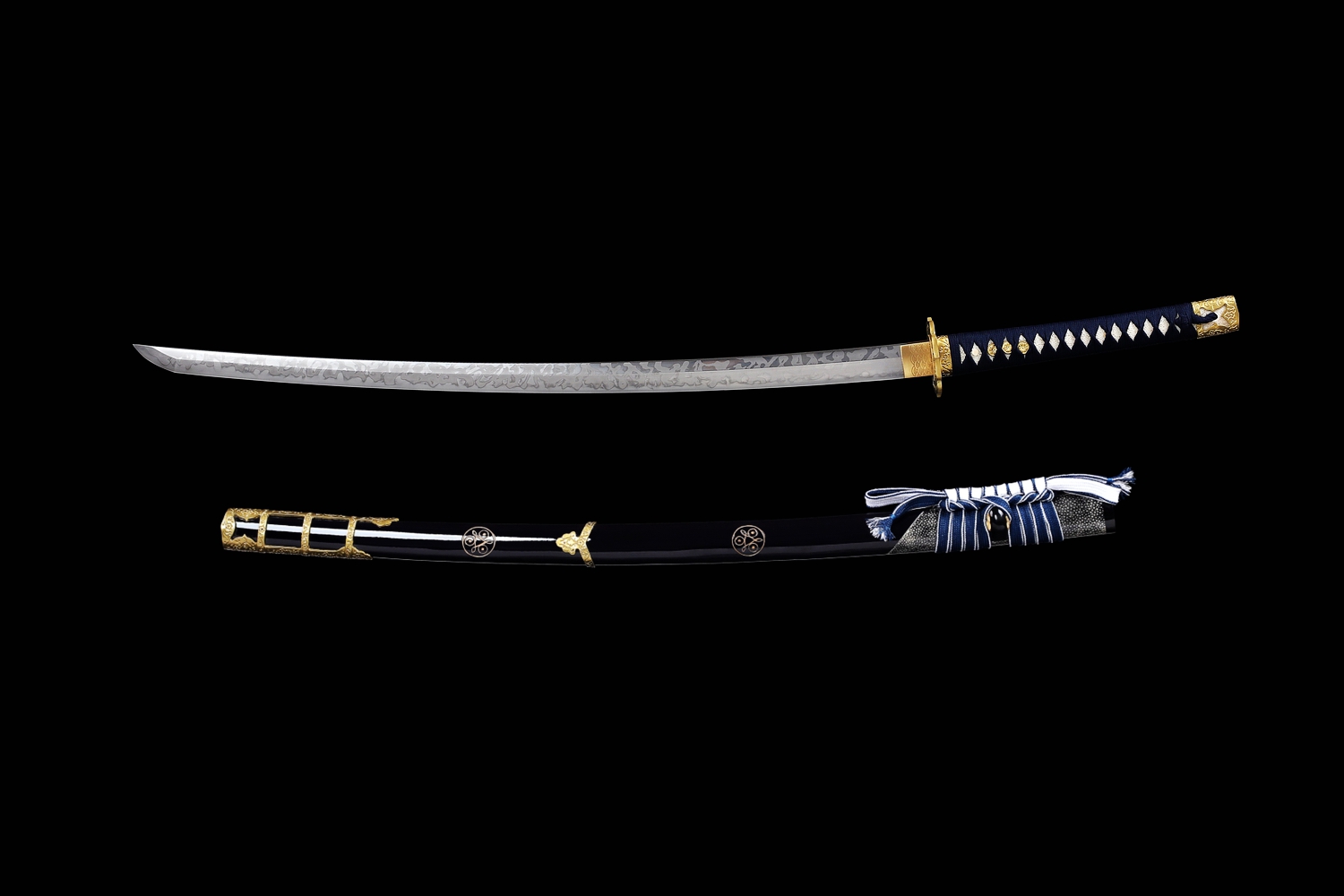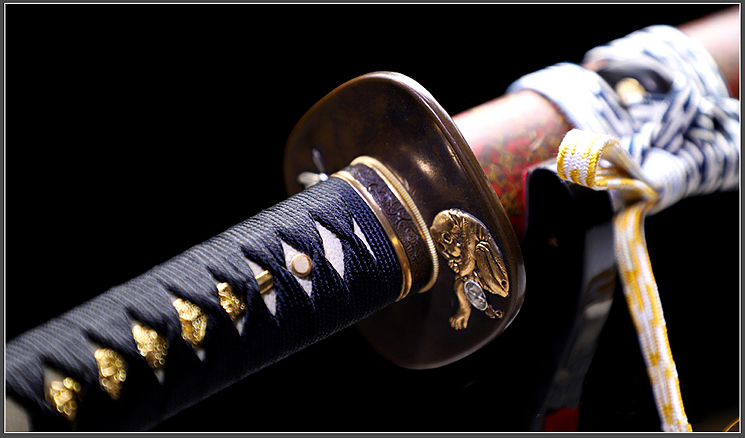Why katana sword of choice for samurai

Bushido believes that the japanese sword is a symbol of strength and spirit. The mere possession of a sword can make a warrior feel self-esteem and a sense of responsibility. The katana embodies his mind and heart, loyalty and honor. Until death, the samurai never separated from his sword.
The katana did not appear until the Kamakura period in Japan (1185 to 1333). It has a curved single-edged blade of about 23 5/8 to 38 3/4 inches (60 to 73 cm), and was the sword of choice for feudal Japanese samurai warriors to wield and use. However, there are dozens of other swords available at this time. So why do most samurai in feudal Japan like katana?
Curved blade:
One of the reasons why many samurai use katana is because of the curved blade of the sword. With its moderately curved blade, the samurai can cut his samurai sword into pieces and attack the opponent in a single smooth movement. This is important because the war during feudal Japan has changed from an open combat environment to a close combat environment. By using the katana, the samurai can quickly draw out the sword and has a competitive advantage over the opponent.
Wear and Cutting Edge:
When viewing photos of traditional Japanese samurai carrying a katana, you may find that, if not all, most samurai wear this sword with the blade facing up. This is in stark contrast to almost all other traditionally opposite swords, which traditionally have the blade facing down. Wearing the katana with the blade facing up can further shorten the drawing time, so that the samurai can quickly draw the sword.
Blade strength:
It is also worth mentioning that the blade of the katana is stronger than the blade of other swords. Japanese blade makers discovered that using high-carbon steel (called tamahagane steel) can produce stronger blades. Before long, almost all diamond sickles were forged with tamahagane steel. As a result, this traditional Japanese sword can withstand greater strength and pressure without suffering damage.
Razor sharp edges:
Ultimately, the katana has a sharp edge, which is essential for the samurai warrior to engage his opponent on the battlefield. After forging a new katana, the swordsmith will pass the newly made sword to others, and his only job is to sharpen it. This is a long and tedious process that involves wiping river rocks on the edge of the blade. In some cases, it may take weeks or even months to fully polish and polish the katana. However, the end result is a sharp sword that can easily cut through cooked leather armor.
Discover the many attractive options available for Katana swords and custom swords.
Feel free to contact us:
Email: sales@shinken-sword.com
Website: www.shinken-sword.com



44 Comment(s)
2 photo of two different katana are used in this blog about the history of the katana, the first one is a new arrival to the website catalog and the and the second katana (picture above) has a blue/yellow sage and tsuba with a demon on it,where can I find the second katana? Is it in the same website for order?
1
1
1
1
1
1
1
1
1
1
1
1
1
1
1
1
1
1
1
1
1
1
1
1
1
1
1
1
1
1
1
Are you looking for a fun and exciting way to spend your time in Delhi? Look no further! Our eye-catching escorts in Delhi are sure to make your stay memorable. With their stunning looks and charming personalities they are the perfect companions for any occasion.
Looking for some excitement in Gwalior? Female escorts might be just what you need! These lovely ladies are here to provide companionship and entertainment for those looking for a good time. With their charm and beauty they can make any evening unforgettable.
Are you looking for some fun and excitement in Mahipalpur? Look no further than the independent Mahipalpur escorts! These lovely ladies are ready to show you a good time and make all your fantasies come true.
If you are looking for companionship in Delhi model escorts can be a great option. These escorts are not only beautiful but also intelligent and charming. They can accompany you to events parties or even just for a quiet evening in.
If you are looking for some fun and excitement in Paharganj then Bhabhi Escorts are the perfect choice for you. These beautiful and charming ladies are ready to show you a good time and make all your fantasies come true.
Are you looking for a special experience in Bangalore? Look no further than VIP Bangalore Escorts! Our escorts are here to make sure you have a memorable time in the city.
Are you looking for some excitement and fun in Delhi? Look no further because our hot Delhi escorts are here to make your dreams come true! With their stunning looks and charming personalities these escorts will ensure you have a memorable experience.
If you are looking for Indian call girls numbers it is important to remember that it is not appropriate to seek out such services. Engaging in activities related to prostitution is illegal in many places and can have serious consequences.
Are you looking for a fun and exciting time in Raipur? Look no further than our high profile escorts service! Our beautiful and talented escorts are here to provide you with a memorable experience that you won't soon forget.
If you are looking for a fun and exciting experience in Dwarka then you should definitely check out the Escorts Service. They provide a range of services to suit your needs and preferences whether you are looking for a dinner date a night out on the town or just some companionship.
Jodhpur Call Girls are a group of women who offer companionship services in the city of Jodhpur. These women are often hired for social events parties or simply for a night out on the town. They provide a listening ear a friendly smile and sometimes even a shoulder to lean on.
Escort services offer a diverse range of companionship and emotional fulfillment options for those seeking to satisfy hidden desires or simply find connection in an otherwise disconnected world.
These services cater to a wide variety of needs, from emotional companionship to more intimate encounters, providing a safe and discreet environment for exploration
However, choosing the right service requires research, careful consideration of safety, and an understanding of ethical implications.
For those who approach it with respect and awareness, escort services can offer a unique and personalized experience that addresses both emotional and physical needs in a way that is professional, consensual, and fulfilling
Sometimes, a man may find it difficult to truly unwind and let go. At times like these, having someone who can listen and be fully present can make all the difference.
1
1
1
1
I appreciate you providing this fantastic blog. It’s incredibly motivating and beneficial, filled with insightful content that I found truly valuable. Your thoughts and ideas are presented in such a clear and engaging way, making it an enjoyable read. I hope you continue to share more of your thoughts and expertise in the future, as I’m sure many readers, including myself, would love to see more of your work. I’ll undoubtedly enjoy reading your future posts. Keep up the great work, and thank you for sharing this inspiring content!
Wow! We couldn’t have produced such an excellent essay without the valuable content you’ve provided. Your insights truly made a difference in shaping the final product. It’s clear that you have a deep understanding of the subject, and your work is incredibly helpful. Do you often explore questions about writing coursework? Your expertise would be a huge asset in that area as well. If you have more tips or advice on coursework writing, I’d love to hear them! Thank you again for your great contribution—keep up the fantastic work!
Incredible article. Extremely fascinating to peruse. I truly love to peruse such a decent article. Much obliged! continue to shake.
here one of the best service
I really liked your blog because it is a very informative article from which I gained a lot of knowledge. If you want to know about us then you must visit our website. We are providing Delhi Independent Escort Service in outcall to all our customers and if you are thinking that the price of their service will be very high then it is not so because we are providing the service of Delhi hot call girls in just Rs. 2999 which is enough to satisfy you completely. Because they have a lot of experience to make you happy.
Discover the allure of high-profile models and actresses, handpicked to exceed your expectations.
Discover the allure of high-profile models and actresses, handpicked to exceed your expectations.
Get ready for non-stop entertainment at Online Matka Play. Your adventure starts here!
We welcome you this time as always because whenever we visit your blog we get a chance to learn and understand a lot. For more information visit here. When it comes to choosing an escort, it's important to communicate clearly about your expectations and desires. Make sure you're on the same page with your escort, and always treat her with dignity and respect. Remember to set clear boundaries and never force her into something she's uncomfortable with. Most importantly, have fun and enjoy yourself! It's a great way to relieve stress, and who doesn't want that? So go ahead and book a date with one of these beautiful Russian Escorts in Delhi.
Most users visit your website to read your blogs and articles because they get a chance to learn and know a lot. For more information, visit here. Many of the Ahmedabad Escorts are talented conversationalists and entertainers, creating an unforgettable experience beyond simple companionship. Serving as cultural ambassadors they introduce clients to local customs, traditions, and attractions and provide laughter and fun that turns a visit into lasting memories.
You can connect with these Delhi Escorts on social media accounts so that you can find out more about them personally as well as what services they provide. An accurate service history provides an accurate reflection of the overall condition of your vehicle, making it easier to identify recurring problems and maintain its value over time. In addition, having this record will also protect warranty and insurance coverage.
Check today's lucky numbers at All Play Bazaar.
The main goal of Blockaway is simple: you need to move blocks on the grid to clear a path for a character or object to reach the exit. Blocks can move horizontally or vertically, but some blocks may be immovable. You need to strategically move these blocks around the grid so that the object can travel to the goal. The challenges increase as you progress, with more blocks, obstacles, and restricted moves introduced at higher levels.
best escorts service
https://www.raipurrose.in/raipur-russian-escorts.html
https://www.raipurrose.in/raipur-hotel-escorts.html
https://www.raipurrose.in/raipur-housewife-escorts.html
https://www.raipurrose.in/raipur-air-hostess-escorts.html
https://www.kolkatarussian.com
Track your wins and view the latest All Play Bazaar Result updates in real-time.
nice post
nice post and thanks for this
My dear brother and if you have not won money in cricket yet and are tired of creating IDs, then please join our website, you will find thousands of games to play through which you can win money
You can trust us 100% right and good, this is such a website on which you will be given a cricket ID, if you join and join, you will get better results from it
Leave a Comment